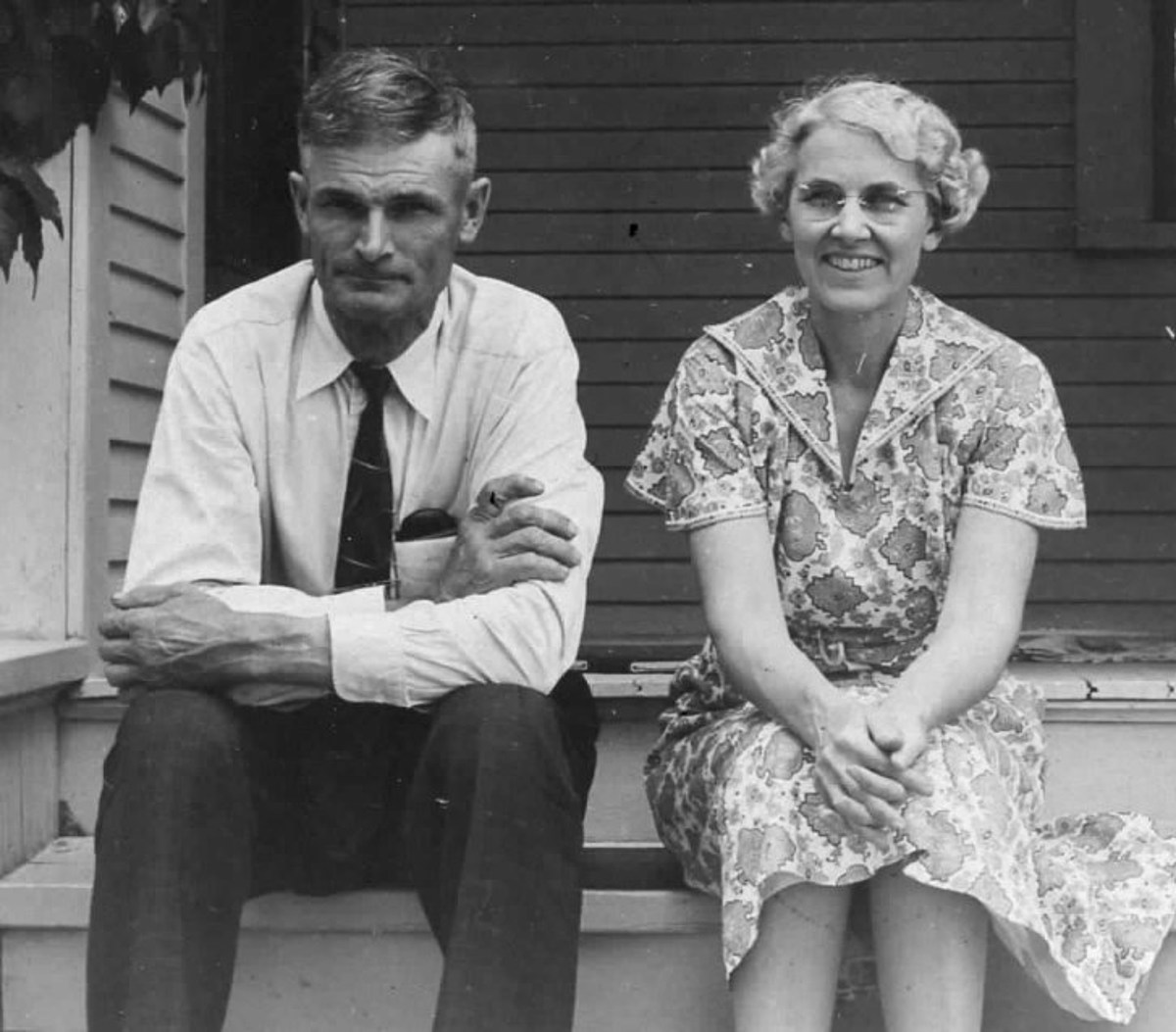Montana
Harmon's Histories: Treasured family stories preserve Montana's hardscrabble history

By Jim Harmon/Missoula Current
This weekly column, as regular readers know, is all about “the news” as reported by the quill drivers of the past – primarily the 1800s into the early 1900s.
Today, I’m going to break from that pattern to offer a story from my family’s past.
This winter I’ve been digitizing old family documents. I encourage everyone – if you haven’t already done it – to ask your parents and grandparents to share stories from their past because, as my father realized, the accuracy of those memories can diminish with time.
In his words, “When we look back on our lives and try to remember all of those happenings which go to make up our history and our parents’ history we realize we did not listen too well. Whatever is fact, and what is remembered as fact, may be miles apart. But the years cannot be brought back to give us a second chance to correct our errors.”
Lee Harmon wearing his first suit ca 1931
Today, I want to share my dad’s story about his dad. We’ll call it, “Mistaken identity leads to a lifelong friendship.”
Lee Harmon (my dad, born in 1916) penned a family history in the 1990s, recalling, “Early in 1919 Dr. Clay, who was the family doctor at Malta told (his) dad (John Harmon, born in 1888) that John had what was then called grain asthma and should move to a different climate.”
“In July 1919, John and another carpenter, Tom Mattox, came west to Eureka to look for work as the mill in Eureka was hiring people at the time. When they arrived there, a mill foreman told them that they had all the men they needed. However he said that the J. Neils Co. in Libby was looking for men, so John and his friend came on to Libby.”
“Tom Mattox was hired as a carpenter, but they only needed one. John was asked if he would like to try sawing in the woods and he took the job.
John D. Harmon with sons, John & Lee ca1920
“By September he wrote to my mother and told her he was feeling much better and had built a logging camp shack, and asked her to sell the place in Malta and come to Libby. Mother was not able to sell the house at that time but found a renter, packed most of our belongings and brought me to Libby where I took root and never got dug up.”
“When we arrived here Mother had to get a room at the old Richards Hotel overnight, and dad came in from logging camp the next evening to get us, and take us to camp. It was a very primitive place to live.”
“The camp shacks were built on skids in those days so they could be loaded on railroad flat cars and taken to the next camp site, wherever that might be. Dad always tried to go to the new location and pick as nice a spot as he could for our home to be planted on. Mother was always afraid of fire, so dad had to clear off, as much as he could, the brush and weeds around the site so it was reasonably safe for us when we finally were moved to the new site.”
Trainer Hill cabins (shacks, actually) ca1919
“How we ever got our family and a great-grandmother, grandmother, and my mother’s aunt all in the one room shack for a visit I’ll never know. After moving to three different camps, between the years 1919 and 1923, in the fall of 1924 we moved into the house on California Ave (in Libby) which the folks had built for them on lots which they had purchased from the John Roche family who lived across the street from them.”
“Frank Pival who was one of the local contractors at that time built the house for them. It was wonderful to have the bathroom in the house instead of out by the big pine tree – real progress!”
John & Pauline Harmon ca 1924
“At the logging camp, a fellow named Gus Svedin had been sawing with another man and when the fellow quit, Gus needed a new partner. Dad went out with Gus and had a very unique experience – the “mistaken identity” incident referred to earlier.
“Gus had heard that a ‘much discussed and disliked man’ was going to be his partner. He jerked the saw and banged Dad’s hands against the tree as they (cross-cut) sawed, and did a number of other things to make Dad mad.”
“At the end of the day Dad asked Gus just what he had done to make him act this way and he replied he didn’t want to work with the so & so, and named the other man. Dad explained that he was not that man. Gus said he was sorry, and from then on he and Dad got along very well.”
“Gus (as a single man) was living in the logging camp, which was not very exciting, so Mother and Dad began asking Gus to come to Sunday dinner with them.
He was very happy to eat a home-cooked meal on Sundays. Mother would make a batch of fudge and they would spend the afternoon playing whist.”
“In succeeding years, Gus sold some oil land he had purchased near Kevin, north of Shelby, and moved to the west coast near Bellingham. Gus bought a small dairy farm and eventually got married, and when his first son was born he named him ‘John’ after Dad.”
“Many years later Dad and Mother went to Bellingham to visit relatives, who took the folks to see Gus and his family who lived near them. It was one of the best reunions Dad ever had. He talked about it for a long time afterward.”
Hopefully this yarn will encourage you to take the time, now, to ask your parents and grandparents to share stories from their past. Don’t live to regret not having done it!
Jim Harmon is a longtime Missoula news broadcaster, now retired, who writes a weekly history column for Missoula Current. You can contact Jim at fuzzyfossil187@gmail.com. His best-selling book, “The Sneakin’est Man That Ever Was,” a collection of 46 vignettes of Western Montana history, is available at harmonshistories.com.

Montana
On second thought: Montana Supreme Court decides not to give attorneys' fees to groups • Daily Montanan

As tensions between two of three Montana branches of government continue to simmer, the Montana Supreme Court reconsidered its position on awarding attorneys’ fees in a case of unconstitutional laws brought by the 2021 Legislature. And, it essentially overturned itself, this time agreeing not to award attorneys’ fees.
It is a rare example of the state’s highest court rehearing a matter it had decided, and late last week, the court fractured into at least four distinct camps on the case, which not only dealt with attorneys’ fees, but also examined the powers of the the Montana University System Board of Regents and the Montana Legislature.
The group consisted of 15 people or groups, including the Montana Federation of Public Employees, the state’s largest union, the Faculty Senate of Montana State University and Mae Nan Ellingson, one of the living original members of the 1972 Constitutional Convention. They had originally sued for a declaration that House Bill 349, 112, 102 and portion of Senate Bill 319 were illegal. They all dealt with higher education in some form, although those bills, which have been struck down, were not the basis of the Supreme Court decisions.
The new decision comes as Montana Senate Republicans launch a committee that is looking at ways to reshape the state’s judiciary. A similar committee was convened in 2021 by Republican leaders in the Legislature, and was the topic of heated political disagreements as the Republicans charged the state’s courts were both opaque and overstepping their boundaries. Meanwhile, Democrats defended the courts, saying they were simply doing their job, evaluating new laws against the state’s Constitution.
The new committee is comprised of Republican lawmakers, and Democrats have vowed to boycott the proceedings.
On Friday, the Montana Supreme Court changed course and decided against awarding attorneys’ fees to groups that brought a suit contending that four bills violated the Montana Constitution. All three of the bills were struck down by a Gallatin County District Court judge, and some of the court’s decision was appealed. However, upon re-examination, the Supreme Court sided with the district court that the Legislature’s actions had overstepped the constitutional provision that gives the Montana University Board of Regents administrative and policy power over the public universities and colleges.
Much of the Supreme Court’s very divided opinion didn’t deal with the subjects of the lawmakers’ bills, which were found to be unconstitutional; rather the high court pivoted to whether a group of university students and professors had the power to bring the lawsuit, and whether they were entitled to recouping attorneys’ fees.
When the Supreme Court originally decided the case, it overturned district court Judge Rienne McElyea’s decision not to award attorney’s fees. The Supreme Court previously argued that because the district court had said the laws were brought in bad faith, meaning the Legislature should have known they violated the Constitution, the groups’ were entitled to attorneys’ fees.
However, upon reconsideration, the Supreme Court was unable to come to enough of a consensus to obtain agreement on the issue of attorneys’ fees, so McElyea’s original decision stands; that means the groups will no longer get attorney’s fees from the state.
On second thought…
The Supreme Court’s decision was one of the more complex decisions, with justices agreeing and disagreeing with each other simultaneously. Five of the seven justices said the groups that originally filed the lawsuit had legal standing to do so.
Meanwhile, Justices Jim Rice and Dirk Sandefur disagreed, in part, saying that the lawsuit should have been brought by the Montana University Board of Regents because they are charged, by the Montana Constitution, with oversight and administration of the university system. They reasoned that if laws passed by the Legislature were problematic, it should have been the regents who responded.
Other justices said that because university students, staff and professors would be affected by the laws that they had legal standing to bring the lawsuit.
“The Board (of Regents)’s failure to initially challenge the subject legislation for whatever reason and its intervening prolonged inaction overwhelmingly demonstrate the necessity for private enforcement,” said Justice Ingrid Gustafson, who wrote parts of the opinion. “The actual student plaintiffs here, who were threatened with actual discrimination, cannot be forced to wait indefinitely for the board to assert its own independence.”
Arguably the most consequential portion of the ruling centered on the issue of attorneys’ fees. Ultimately, the high court ruled that while Montana state law allows attorneys’ fees to be awarded to groups or individuals that successfully sue the government for unconstitutional laws, under a legal theory known as the “private attorney general doctrine,” those fees are discretionary, not mandatory.
The court then reconsidered the findings of McElyea, and some justices reasoned that while there were several points that could have triggered an attorneys’ fees award, it was discretionary so the finding of lower court should be upheld.
However, in the opinion written by Justice Gustafson, and joined by Laurie McKinnon, both said that they still found that not only had the Legislature acted in bad faith when passing the laws, but that it could be argued that the Board of Regents should have fought back against the Legislature’s encroachment on their authority. Furthermore, the groups should be awarded the attorneys’ fees for essentially having to do someone else’s job.
“While we need not make a judicial determination of bad faith in this case, there are indications where one could question whether the state was not entirely acting in good faith by defending all of the bills at issue here. One such indication is that the state did not even brief any merits defense for two of the three challenged bills after the district court declared them unconstitutional. Yet the state, in its zeal to impose unconstitutional legislative enactments against the board and the Montana University System, continue to assert the plaintiffs could not even bring the claim against those laws the state concedes are unconstitutional.”
They also argued that the groups should be awarded attorneys’ fees for actually vindicating rights found in the Montana Constitution, namely those of the Board of Regents’ and its authority over the university system.
“Attorney fees are proper because of the process through which the unconstitutional bills came to be: Patently unconstitutional bills adopted through the willful disregard of constitutional obligation,” the Gustafson-McKinnon opinion said. “Assessing fees when plaintiffs successfully challenge legislation which came about through such unconstitutional means may serve to deter wrongdoing in the first place.”
Meanwhile, Chief Justice Mike McGrath and Justices Beth Baker and James Jeremiah Shea said that while the court could have awarded attorneys fees, that there are many factors that could have triggered the award, and the court would not second-guess the district court because the award is not mandatory.
“As noted by the district court, there was an independent entity of state government here who could have enforced its constitutional authority — the Board of Regents. The board is often willing and able to defend its constitutional authority. Plaintiffs here did not make the necessary showing that the board was unwilling or able, for whatever reason, to challenge these laws,” McGrath wrote.
Finally, Sandefur and Rice didn’t discuss the merits of the case or attorneys’ fees because they argued that the group shouldn’t have legal standing in the case, and that the only group with standing was the Board of Regents.
“Such decisions are inherent to the ‘full power, responsibility, and authority to supervise, coordinate, manage and control the Montana University System,’ and necessarily should be made exclusively by the board itself, not by an amorphous group of surrogates,” said Rice and Sandefur.
Reversal attorneys fees
Montana
The path to a better tuberculosis vaccine runs through Montana

A team of Montana researchers is playing a key role in the development of a more effective vaccine against tuberculosis, an infectious disease that has killed more people than any other.
The BCG (Bacille Calmette-Guérin) vaccine, created in 1921, remains the sole TB vaccine. While it is 40% to 80% effective in young children, its efficacy is very low in adolescents and adults, leading to a worldwide push to create a more powerful vaccine.
One effort is underway at the University of Montana Center for Translational Medicine. The center specializes in improving and creating vaccines by adding what are called novel adjuvants. An adjuvant is a substance included in the vaccine, such as fat molecules or aluminum salts, that enhances the immune response, and novel adjuvants are those that have not yet been used in humans. Scientists are finding that adjuvants make for stronger, more precise, and more durable immunity than antigens, which create antibodies, would alone.
Eliciting specific responses from the immune system and deepening and broadening the response with adjuvants is known as precision vaccination. “It’s not one-size-fits-all,” said Ofer Levy, a professor of pediatrics at Harvard University and the head of the Precision Vaccines Program at Boston Children’s Hospital. “A vaccine might work differently in a newborn versus an older adult and a middle-aged person.”
The ultimate precision vaccine, said Levy, would be lifelong protection from a disease with one jab. “A single-shot protection against influenza or a single-shot protection against COVID, that would be the holy grail,” Levy said.
Jay Evans, the director of the University of Montana center and the chief scientific and strategy officer and a co-founder of Inimmune, a privately held biotechnology company in Missoula, said his team has been working on a TB vaccine for 15 years. The private-public partnership is developing vaccines and trying to improve existing vaccines, and he said it’s still five years off before the TB vaccine might be distributed widely.
It has not gone unnoticed at the center that this state-of-the-art vaccine research and production is located in a state that passed one of the nation’s most extreme anti-vaccination laws during the pandemic in 2021. The law prohibits businesses and governments from discriminating against people who aren’t vaccinated against COVID-19 or other diseases, effectively banning both public and private employers from requiring workers to get vaccinated against COVID or any other disease. A federal judge later ruled that the law cannot be enforced in health care settings, such as hospitals and doctors’ offices.
In mid-March, the Bill & Melinda Gates Medical Research Institute announced it had begun the third and final phase of clinical trials for the new vaccine in seven countries. The trials should take about five years to complete. Research and production are being done in several places, including at a manufacturing facility in Hamilton owned by GSK..
Known as the forgotten pandemic, TB kills up to 1.6 million people a year, mostly in impoverished areas in Asia and Africa, despite its being both preventable and treatable. The U.S. has seen an increase in tuberculosis over the past decade, especially with the influx of migrants, and the number of cases rose by 16% from 2022 to 2023. Tuberculosis is the leading cause of death among people living with HIV, whose risk of contracting a TB infection is 20 times as great as people without HIV.
“TB is a complex pathogen that has been with human beings for ages,” said Alemnew Dagnew, who heads the program for the new vaccine for the Gates Medical Research Institute. “Because it has been with human beings for many years, it has evolved and has a mechanism to escape the immune system. And the immunology of TB is not fully understood.”
The University of Montana Center for Translational Medicine and Inimmune together have 80 employees who specialize in researching a range of adjuvants to understand the specifics of immune responses to different substances. “You have to tailor it like tools in a toolbox towards the pathogen you are vaccinating against,” Evans said. “We have a whole library of adjuvant molecules and formulations.”
Vaccines are made more precise largely by using adjuvants. There are three basic types of natural adjuvants: aluminum salts; squalene, which is made from shark liver; and some kinds of saponins, which are fat molecules. It’s not fully understood how they stimulate the immune system. The center in Missoula has also created and patented a synthetic adjuvant, UM-1098, that drives a specific type of immune response and will be added to new vaccines.
One of the most promising molecules being used to juice up the immune system response to vaccines is a saponin molecule from the bark of the quillay tree, gathered in Chile from trees at least 10 years old. Such molecules were used by Novavax in its COVID vaccine and by GSK in its widely used shingles vaccine, Shingrix. These molecules are also a key component in the new tuberculosis vaccine, known as the M72 vaccine.
But there is room for improvement.
“The vaccine shows 50% efficacy, which doesn’t sound like much, but basically there is no effective vaccine currently, so 50% is better than what’s out there,” Evans said. “We’re looking to take what we learned from that vaccine development with additional adjuvants to try and make it even better and move 50% to 80% or more.”
By contrast, measles vaccines are 95% effective.
According to Medscape, around 15 vaccine candidates are being developed to replace the BCG vaccine, and three of them are in Phase III clinical trials.
One approach Evans’ center is researching to improve the new vaccine’s efficacy is taking a piece of the bacterium that causes TB, synthesizing it, and combining it with the adjuvant QS-21, made from the quillay tree. “It stimulates the immune system in a way that is specific to TB and it drives an immune response that is even closer to what we get from natural infections,” Evans said.
The University of Montana center is researching the treatment of several problems not commonly thought of as treatable with vaccines. They are entering the first phase of clinical trials for a vaccine for allergies, for instance, and first-phase trials for a cancer vaccine. And later this year, clinical trials will begin for vaccines to block the effects of opioids like heroin and fentanyl.
The University of Montana received the largest grant in its history for anti-opioid vaccine research. It works by creating an antibody that binds with the drug in the bloodstream, which keeps it from entering the brain and creating the high.
For now, though, the eyes of health care experts around the world are on the trials for the new TB vaccines, which, if they are successful, could help save countless lives in the world’s poorest places.
2024 KFF Health News. Distributed by Tribune Content Agency, LLC.
Citation:
The path to a better tuberculosis vaccine runs through Montana (2024, April 29)
retrieved 29 April 2024
from https://medicalxpress.com/news/2024-04-path-tuberculosis-vaccine-montana.html
This document is subject to copyright. Apart from any fair dealing for the purpose of private study or research, no
part may be reproduced without the written permission. The content is provided for information purposes only.
Montana
Heavy police presence will continue at the University of Montana Campus throughout the night

UPDATE 10:47 P.M. April 28, 2024
MISSOULA- MTN News received the following email.
“UMPD in partnership with Missoula law enforcement continue to search the campus but have not found anything or received information to substantiate a threat. University operations are returning to normal but we ask for your continued vigilance and that you report anything you see that appears suspicious to UMPD (x4000 or 406-243-4000). Officers will continue to patrol campus throughout the night. Thank you for your cooperation and have a good evening.”
MISSOULA- The University of Montana and the Missoula Police Department are investigating after two calls were placed to 911 threatening gun violence at the University.
Officials said they received the call around 9 p.m. on Sunday.
The University of Montana sent this email to family’s and students on Sunday night following the report:
“911 received an anonymous call of a person dressed in black threatening violence on campus (including the use of firearms). There has been no verification to this call however the University has gone to secure mode by locking all external buildings. Police are actively searching campus.
Anyone on campus should be vigilant and if you see anything suspicious to call University Police. Anyone attending the show at the Adams Center can exit orderly at end of show and there are police on scene .
If anyone has information or sees anything unfamiliar, please call Missoula 911, or University Police Emergency at 4000 (on campus), 406-243-4000 (off campus).”
There will continue to be a heavy police presence on campus tonight as campus remains in safety mode, meaning that if a student has a key to get into a door they will be allowed in but external doors will be locked, according to the UM Communications Director Dave Kuntz.
Kuntz told MTN that there is no indication that this is connected to the Protecting Freedom event that occurred earlier on Sunday.
Police are actively searching the campus for any indication of the threat. There is currently no evidence of a threat to the public.
-

 World1 week ago
World1 week agoShipping firms plead for UN help amid escalating Middle East conflict
-

 Politics1 week ago
Politics1 week agoICE chief says this foreign adversary isn’t taking back its illegal immigrants
-

 Politics1 week ago
Politics1 week ago'Nothing more backwards' than US funding Ukraine border security but not our own, conservatives say
-

 News1 week ago
News1 week agoThe San Francisco Zoo will receive a pair of pandas from China
-

 World1 week ago
World1 week agoTwo Mexican mayoral contenders found dead on same day
-

 World1 week ago
World1 week agoBrussels, my love? The EU single market is not sexy enough for voters
-

 Politics1 week ago
Politics1 week agoRepublican aims to break decades long Senate election losing streak in this blue state
-

 World1 week ago
World1 week agoEU sanctions extremist Israeli settlers over violence in the West Bank



















